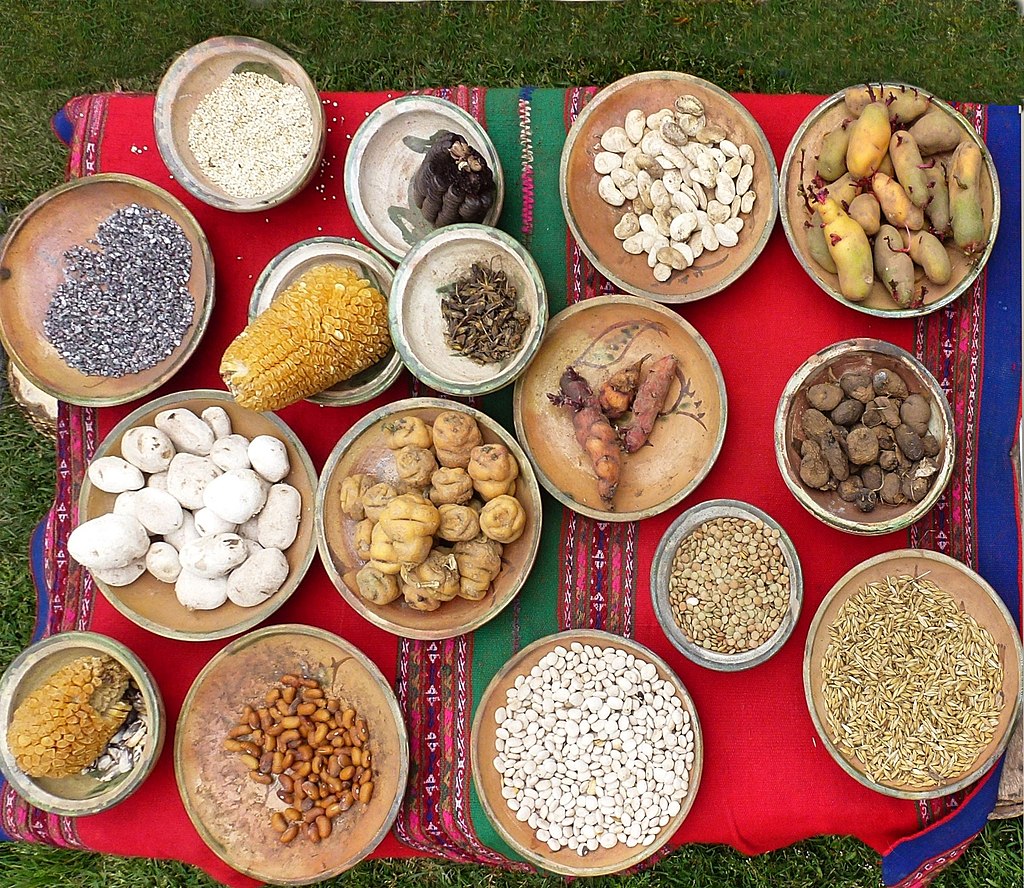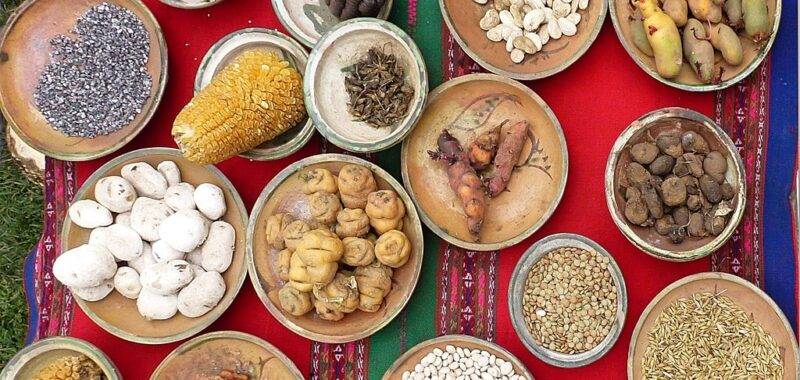
Photograph by Pierre André Leclercq, via Wikimedia Commons. Licensed under CC BY-SA 4.0.
The Bean Bible is at once an apologetic for the world’s legumes and also somewhat apologetic about them. The Bible is dedicated to the author’s husband, who “never objected to endless nights of bean meals”; a blurb identifies its subject as the ultimate underdog: “oft-maligned, subjected to ridicule, and despised by children everywhere.”
Twenty-four years after its publication, things have changed. Beans are no longer synonymous with flatulence alone, and the only reason you wouldn’t be able to purchase a quarterly heirloom bean subscription is because Rancho Gordo is sold out. When I find myself yearning for an ideologically purer legumania, however, I still find myself turning to the Bible, a time capsule of the far more ascetic era of vegetarianism that raised me on black bean quesadillas and chickpea soup.
Caveat here: The Bean Bible is not actually a vegetarian cookbook. (It includes nearly half a dozen recipes for duck alone.) But it reflects a world in which meatless staples were far less ubiquitous than they are today, purporting to introduce readers to “the Lebanese chickpea spread hummus” and canned beans from “the Puerto Rican brand Goya.” Directed at an adventurous but naive readership, the Bible remains worldly enough to have earned the ire of at least one Goodreads reviewer frustrated by the book’s focus on “East India cooking.”
But I don’t read the Bible for its recipes. What makes it special is its systematic review of the legumes themselves, particularly chapter one’s genealogical (beanealogical?) charts, which I like to meditate upon as though they catalogued the names of my ancestors: cowpea, goober pea, lady pea; mortgage lifter bean and blue shackamaxon; beluga lentil and pardina lentil and speckled minisink. (Rumor has it that the European soldier bean and the French navy bean are still fighting it out on page eight.) Whether or not I ever cook any of those pedigreed varietals—almost certainly I will not—I’m honored to be just one of a long, long line of FODMAP enthusiasts.
—Emmet Frazier, intern
Like many of the best cookbooks, Full Moon Feast suggests that there is an order to life via food and that, if we follow it, we will be okay. In the first chapter, Jessica Prentice shares her personal journey out of disorder. As a teenager newly aware of both animal rights and beauty standards, she tried to avoid almost every food group. Inevitably hungry, she would binge on junk before guiltily returning to a raw vegetable diet. It was only when she began eating seasonally that she was able to find balance. Thus chapter one is about the Hunger Moon, sometime around February, when fresh food is hard to find in the Northern Hemisphere. Nature appoints a time for austerity, Prentice discovered, just as it appoints other times for plenty, and the chapter’s opening essay is followed by root-cellar recipes for parsnip soup and borscht. After “Hunger Moon” comes “Sap Moon,” in which Prentice describes the traditional processes of making maple, coconut, and palm sugar—developed by people with ancestral connections to the source plants and the earth in which they grew—in contrast to the history of violent displacement that underlies industrially refined white sugar. (Not that she is anti-dessert. “Sap Moon” recipes for panna cruda and rice pudding use maple, coconut, and palm sugar, with sustainable sources for each listed in the back of the book.) Skipping forward a few moons to summer, the chapter on the Mead Moon, which ponders spiritual ritual intoxication dating back to Greek bacchanalia, segues nicely into the one on the Wort Moon, which explores the interrelated histories of herbal medicine and brewing—traditions that, in Europe, were irreparably damaged by witch burnings. In each chapter, Prentice explores how different cultures use natural cycles of abundance to nourish body and soul. She also unpacks the ways that today’s economy and culture have disturbed traditional values that were once shared across many cultures—for example, she links the degradation of dairy to both capitalism and misogyny. Rather than judgy, her tone is curious, thoughtful, and unhurried, like a certain kind of yoga lecture, and with a similar restorative effect.
—Jane Breakell, development director
“Welcome to the oasis. I hope you like it here,” writes Rawaan Alkhatib at the beginning of Hot Date!: Sweet and Savory Recipes Celebrating the Date, from Party Food to Everyday Feasts, the most sumptuous cookbook I’ve ever encountered. Hot Date! is of course a cheeky title, and it’s a fun game to read date with its romantic English cognate, especially in sentences such as “There’s an Arabic saying about how to get your palm trees to grow the sweetest dates: Keep their feet in the water and their heads in the fires of hell.” From “Party Food” through breakfasts, main courses, sides, desserts, and condiments, every recipe includes dates or a date-based product—which might seem like a narrow constraint, but this oasis is a world.
Alkhatib, in addition to being a prodigious chef, is a poet, museum designer, and fantastically whimsical illustrator. (When she was in graduate school, she handed around homemade chocolate truffles at a poetry reading and directed audience members to begin eating them at the beginning of one of her poems, which was written in the shape of chemical bonds for a particular kind of sugar. When she got to the center of the poem, the audience started crackling: there were Pop Rocks hidden in the chocolates, exploding mouths with fireworks at the very moment she reached the center of the “sugar” in the poem itself.)
The cookbook opens with an illustrated “Guide to the Date,” from the ajwa (“considered the prophet Mohammad’s favorite variety”), to the khalas (“the ne plus ultra of dates … Complex flavor with notes of honey butter, sweet potato, ripe sugarcane, and toasted caramel released in successive waves, with a nutty taffy finish”), to the tiny but mighty zamli (with “toffee-textured flesh”). The recipes have names that make them parade off the page: Curried Sausage Rolls with a Surprise Inside, Sculptural Breakfast Bars, 13-Hour Lamb with Date and Feta Relish, Whole Roasted Pineapple Draped in Spiced Caramel. Even the more calorically austere ones—carrot soup, celery salad—manage to be decadent in their descriptions.
Dates are the star, but Alkhatib gives the dates dates, too, introducing a dramatis personae of other pantry items that enhance the fruit: bulgur, black sesame paste, cardamom, desert truffles (“imagine a sandy potato but with an air of mystique”), ghee (“make butter better by making it more buttery than butter”), nigella (Alkhatib’s mother shipped her a bottle with the phrase “CURES ANYTHING BUT DEATH”), vanilla beans (seemingly commonplace, but “one of the only orchids to produce a foodstuff that’s edible to humans” and a compound in both breast milk and baby formulas). Don’t sleep on the Stuffed Date “Notions” (“Plantain Chip + Lime + Crema + Cilantro”), “Marzipan!,” and “Suggested Menus” at the end. Savor this book with your sweetheart, take yourself out on your own date: Hot Date! is a joy.
—Adrienne Raphel

